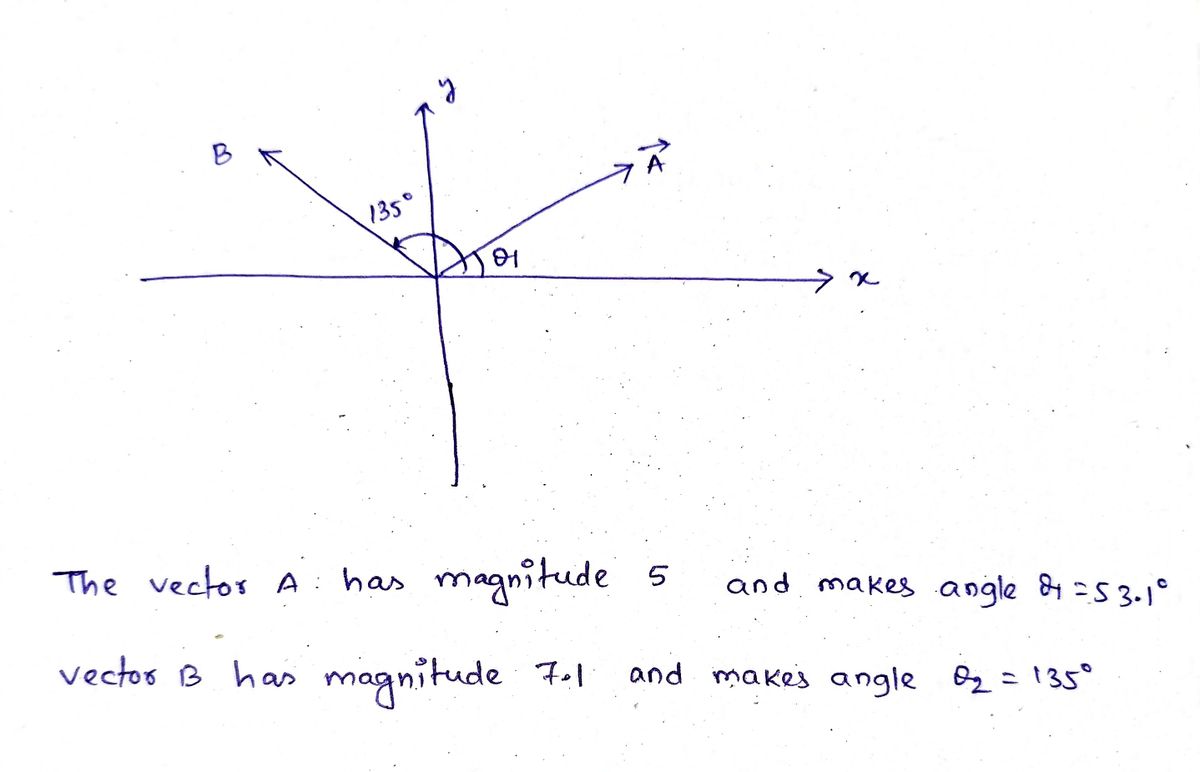B. USING THE BASE VECTORS, MAKE VECTOR-A HAVE A MAGNITUDE 5, AND AN ANGLE OF 53.1 DEGREES TO BE IN QUADRANT 1, AND USING THE BASE VECTORS, MAKE VECTOR-B HAVE A MAGNITUDE 7.1, AND AN ANGLE OF 135 DEGREES WITH THE POSITIVE X-AXIS TO BE IN QUADRANT 2. COMPUTE THE MAGNITUDE AND DIRECTION OF RESULTANT VECTOR-C. WHAT QUADRANT IS THE RESULTANT IN? VERIFY WITH THE SIMULATION. SUPPLY A SCREEN SHOT.
B. USING THE BASE VECTORS, MAKE VECTOR-A HAVE A MAGNITUDE 5, AND AN ANGLE OF 53.1 DEGREES TO BE IN QUADRANT 1, AND USING THE BASE VECTORS, MAKE VECTOR-B HAVE A MAGNITUDE 7.1, AND AN ANGLE OF 135 DEGREES WITH THE POSITIVE X-AXIS TO BE IN QUADRANT 2. COMPUTE THE MAGNITUDE AND DIRECTION OF RESULTANT VECTOR-C. WHAT QUADRANT IS THE RESULTANT IN? VERIFY WITH THE SIMULATION. SUPPLY A SCREEN SHOT.
College Physics
11th Edition
ISBN:9781305952300
Author:Raymond A. Serway, Chris Vuille
Publisher:Raymond A. Serway, Chris Vuille
Chapter1: Units, Trigonometry. And Vectors
Section: Chapter Questions
Problem 1CQ: Estimate the order of magnitude of the length, in meters, of each of the following; (a) a mouse, (b)...
Related questions
Question
Here below I provided the link that goes with the image attached
https://phet.colorado.edu/en/simulations/vector-addition
Click the link and click on equations
Don't forget to provide a screenshot
Please please try to answer everything please please answer it's super important I would really appreciate it if you would answer

Transcribed Image Text:B. USING THE BASE VECTORS, MAKE VECTOR-A HAVE A MAGNITUDE 5, AND AN ANGLE OF 53.1
DEGREES TO BE IN QUADRANT 1, AND USING THE BASE VECTORS, MAKE VECTOR-B HAVE A
MAGNITUDE 7.1, AND AN ANGLE OF 135 DEGREES WITH THE POSITIVE X-AXIS TO BE IN
QUADRANT 2. COMPUTE THE MAGNITUDE AND DIRECTION OF RESULTANT VECTOR-C. WHAT
QUADRANT IS THE RESULTANT IN? VERIFY WITH THE SIMULATION. SUPPLY A SCREEN SHOT.
Expert Solution
Step 1: Determine the given variables

Step by step
Solved in 4 steps with 3 images

Knowledge Booster
Learn more about
Need a deep-dive on the concept behind this application? Look no further. Learn more about this topic, physics and related others by exploring similar questions and additional content below.Recommended textbooks for you

College Physics
Physics
ISBN:
9781305952300
Author:
Raymond A. Serway, Chris Vuille
Publisher:
Cengage Learning

University Physics (14th Edition)
Physics
ISBN:
9780133969290
Author:
Hugh D. Young, Roger A. Freedman
Publisher:
PEARSON

Introduction To Quantum Mechanics
Physics
ISBN:
9781107189638
Author:
Griffiths, David J., Schroeter, Darrell F.
Publisher:
Cambridge University Press

College Physics
Physics
ISBN:
9781305952300
Author:
Raymond A. Serway, Chris Vuille
Publisher:
Cengage Learning

University Physics (14th Edition)
Physics
ISBN:
9780133969290
Author:
Hugh D. Young, Roger A. Freedman
Publisher:
PEARSON

Introduction To Quantum Mechanics
Physics
ISBN:
9781107189638
Author:
Griffiths, David J., Schroeter, Darrell F.
Publisher:
Cambridge University Press

Physics for Scientists and Engineers
Physics
ISBN:
9781337553278
Author:
Raymond A. Serway, John W. Jewett
Publisher:
Cengage Learning

Lecture- Tutorials for Introductory Astronomy
Physics
ISBN:
9780321820464
Author:
Edward E. Prather, Tim P. Slater, Jeff P. Adams, Gina Brissenden
Publisher:
Addison-Wesley

College Physics: A Strategic Approach (4th Editio…
Physics
ISBN:
9780134609034
Author:
Randall D. Knight (Professor Emeritus), Brian Jones, Stuart Field
Publisher:
PEARSON